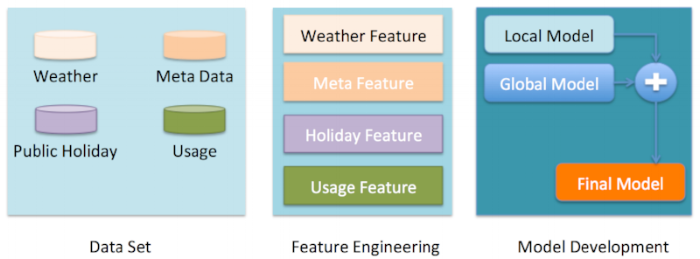
August 8, 2018
Forecasting Building Energy Consumption

Tam Nguyen
Building energy forecasting has gained momentum with the increase of building energy efficiency research and solution development. Indeed, forecasting the global energy consumption of a building can play a pivotal role in the operations of the building. It provides an initial check for facility managers and building automation systems to mark any discrepancy between expected and actual energy use. Accurate energy consumption forecasts are also used by facility managers, utility companies and building commissioning projects to implement energy-saving policies and optimize the operations of chillers, boilers and energy storage systems.
The problem with building energy consumption forecasting is that the usage patterns are different from one to another. For instance, while restaurants would use more electricity during lunch and dinner, office buildings tend to use less energy during that time. Moreover, for new customers, there is less historical data, which is insufficient to build a good model. How to leverage past usage data of other buildings to develop a better model is still in question.
Presented in this blog post is Utegration’s solution to tackle the building energy forecasting problem that not only takes into account the building historical data itself but also aims at capturing its neighbour “behaviours” as well as other traditional data sources such as weather, calendar, and building metadata to maximize the forecasting power. The proposed solution has been proven to be one of the most accurate approaches in an international competition organized by DrivenData in association with Schneider Electric.
Problem description
Given historical building consumption data, historical weather data and weather forecast for one or a few places geographically close to the building, calendar information (identifying working and off days), meta-data about the building (whether it is an office space, a restaurant, etc.), the goal is to forecast consumption accurately.
Proposed solution
A few challenges of this problem can be named as follows. There are many sites/buildings to forecast, and it is unfeasible to develop a predictive model for each site. Moreover, the lack of historical data makes the model less accurate when building a personalized or local model for the site. Another challenge is making predictions at various time scales, i.e. 15 minutes, hourly, and daily. All site historical data to build a global model could be used, but it might lead to under-fitting. For instance, an office building and a shopping mall probably have different usage patterns. Hence, there is a need to trade-off between the two kinds of models to have the best performance.
The following figure demonstrates our team’s overall solution for building energy consumption forecasting including two major steps: feature engineering and model development. Four separate feature sets were built based on 4 data sets such as weather, metadata, holiday, and usage. Then, two kinds of models were built, including local and global models. For local models, there are three different models for 15 minutes, 1 hour, and 1 day forecasting. Global models are trained on the whole data sets ignoring the time scale or frequency.

In this solution, weather data, building metadata, holiday data, and usage data are leveraged to build the best solution. Features from the 4 data sets were intensively engineered based on the team’s domain knowledge in utilities.
Electricity consumption usually can be decomposed into two parts: non-weather related and weather related. The former includes usages consumed by computation devices such as laptops, tablets, desktops, etc. in an office building, or assembly lines in a factory, or lights for underground structure etc. Changes in temperature or humidity don’t have direct impact on the consumption of these devices. On the other hand, the latter is impacted by climate sensitive appliances/machines, for example, air conditioners.
Depending on premise type, weather related consumption can sometimes be the major part of the total consumption associated with a premise. To capture this indicator, heating-degree-days and cooling-degree-days features are generated based on different bases of heating/cooling temperature. Moreover, some buildings consume less energy during various periods of time, such as weekends and at night, and the models take into account this seasonal information to make better predictions. Additionally, similarity between buildings using metadata and holiday data is calculated.
For model development, our team merged weather features, metadata features, holiday features, and usage features to build both local and global models.
Then, traded off the influence of the two models using an optimization algorithm. Our proposed solution is ranked #5 out of a few hundred international teams.